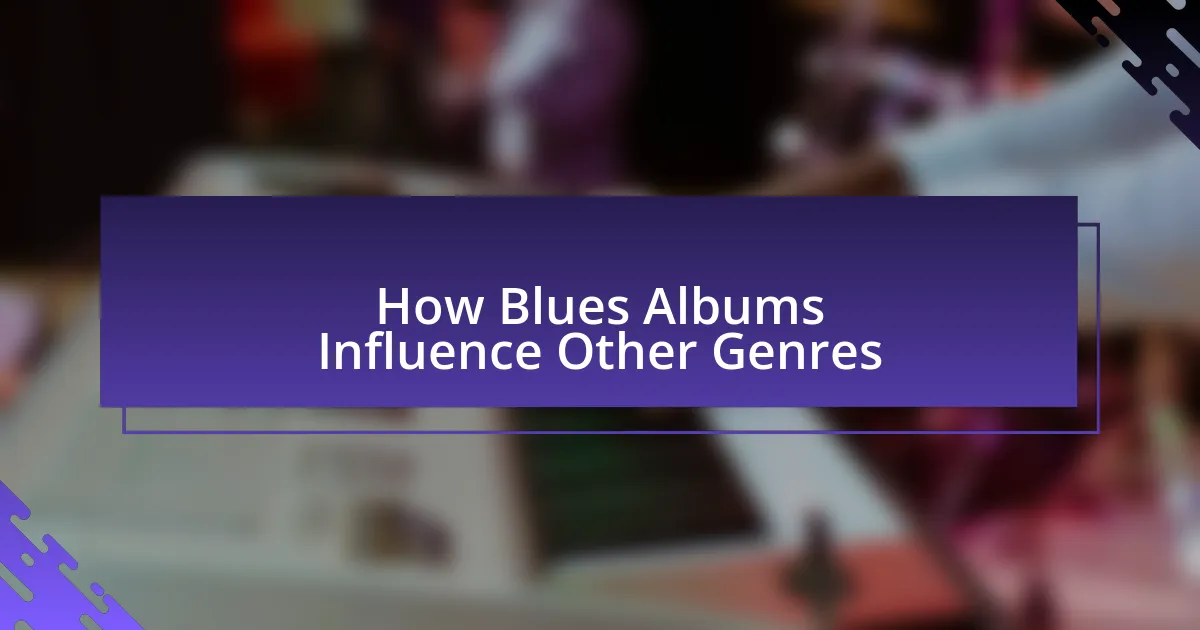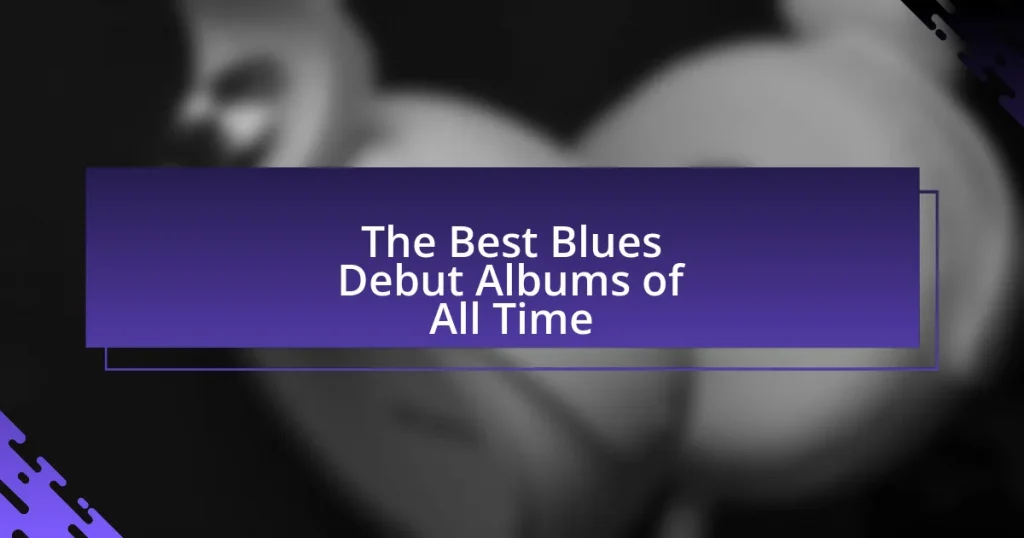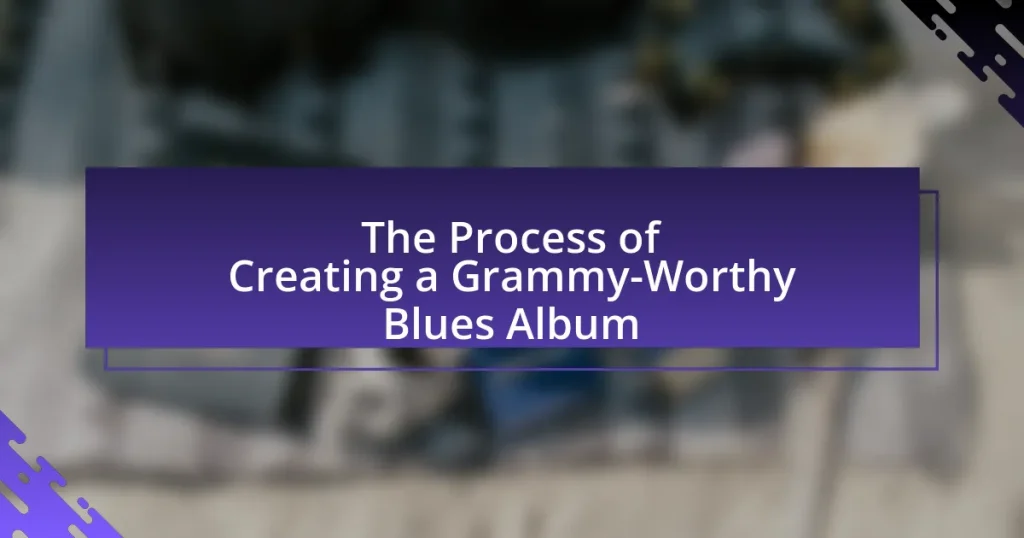Blues albums play a crucial role in influencing various music genres by introducing foundational elements such as chord progressions, lyrical themes, and improvisational techniques. The twelve-bar blues structure has been widely adopted in rock, jazz, and country music, while the emotional depth and storytelling found in blues lyrics resonate in genres like hip-hop and folk. This article explores the key characteristics of blues music, its historical context, and how contemporary artists incorporate blues elements into their work, highlighting the genre’s lasting impact on popular music and its significance in shaping the musical landscape.

How do Blues Albums Influence Other Genres?
Blues albums significantly influence other genres by providing foundational elements such as chord progressions, lyrical themes, and improvisational techniques. For instance, the twelve-bar blues structure has been adopted in rock, jazz, and country music, shaping their harmonic frameworks. Additionally, artists like Eric Clapton and The Rolling Stones have cited blues musicians such as B.B. King and Muddy Waters as primary influences, demonstrating how blues has permeated rock music. The emotional depth and storytelling found in blues lyrics have also inspired genres like hip-hop and folk, where personal narratives are central. This cross-genre impact is evident in the works of contemporary artists who blend blues with pop and electronic music, further showcasing the genre’s versatility and lasting legacy.
What are the key characteristics of Blues music?
Blues music is characterized by its use of specific chord progressions, particularly the twelve-bar blues, expressive lyrics often reflecting themes of sorrow and hardship, and a distinctive call-and-response pattern. The twelve-bar blues structure typically involves three chords and is foundational to the genre, influencing countless other musical styles. The lyrical content often conveys personal experiences and emotions, which adds depth and relatability to the music. Additionally, the call-and-response technique, rooted in African musical traditions, creates an interactive dynamic between the performer and the audience, enhancing the emotional impact of the performance. These characteristics have made blues a significant influence on various genres, including rock, jazz, and R&B.
How do these characteristics manifest in Blues albums?
Characteristics of Blues manifest in albums through specific musical elements, lyrical themes, and structural formats. Musically, Blues albums often feature a 12-bar structure, expressive guitar solos, and a call-and-response pattern, which are foundational to the genre. Lyrically, themes of hardship, love, and resilience are prevalent, reflecting the emotional depth and storytelling tradition of Blues. For instance, B.B. King’s “The Thrill Is Gone” exemplifies this with its poignant lyrics and soulful guitar work. Additionally, the use of blue notes and improvisation in performances highlights the genre’s influence on subsequent styles, such as Rock and Jazz, demonstrating how these characteristics shape the broader musical landscape.
Why are these characteristics significant for genre influence?
The characteristics of blues albums are significant for genre influence because they establish foundational elements that other genres adopt and adapt. Blues features distinct musical structures, such as the twelve-bar blues progression, which has been integrated into rock, jazz, and country music, demonstrating its pervasive impact. Additionally, the emotional expression and storytelling inherent in blues lyrics resonate across genres, influencing artists to convey deeper narratives in their own music. This cross-genre adoption is evidenced by the success of artists like Eric Clapton and The Rolling Stones, who have openly credited blues musicians as key influences in their work, thereby showcasing the genre’s lasting legacy and transformative power in shaping contemporary music.
In what ways have Blues albums shaped popular music?
Blues albums have significantly shaped popular music by introducing foundational elements such as chord progressions, lyrical themes, and instrumental techniques that have influenced various genres. The twelve-bar blues structure, characterized by its specific chord progression, has been adopted by rock, jazz, and country music, creating a common musical language. Artists like B.B. King and Muddy Waters have not only popularized blues but also inspired rock legends like Eric Clapton and The Rolling Stones, who have cited blues as a primary influence in their work. Furthermore, the emotional depth and storytelling found in blues lyrics have permeated pop and hip-hop, with artists like Bob Dylan and Kendrick Lamar drawing from blues traditions to convey complex narratives. This cross-genre influence illustrates how blues albums have laid the groundwork for the evolution of modern popular music.
What genres have been most influenced by Blues albums?
Blues albums have most significantly influenced rock, jazz, and R&B genres. The connection between blues and rock is evident in the works of artists like Eric Clapton and The Rolling Stones, who incorporated blues elements into their music, leading to the development of rock and roll in the 1950s. Jazz musicians, such as Miles Davis and John Coltrane, have also drawn from blues structures and improvisational techniques, enriching the genre’s complexity. Additionally, R&B emerged from the blues tradition, with artists like Ray Charles and Aretha Franklin blending blues with gospel and jazz influences, shaping the sound of modern soul music. These relationships illustrate the foundational role of blues in the evolution of these genres.
How do artists from other genres incorporate Blues elements?
Artists from other genres incorporate Blues elements by integrating its characteristic chord progressions, rhythms, and emotional expression into their music. For instance, rock musicians often utilize the twelve-bar blues structure, which is foundational in blues music, to create a familiar yet innovative sound. Additionally, hip-hop artists frequently sample blues melodies or lyrics, drawing on the genre’s themes of struggle and resilience to enhance their storytelling. This blending of styles is evident in the works of artists like The Rolling Stones, who have openly acknowledged their blues influences, and in the music of contemporary artists like Gary Clark Jr., who merges blues with rock and soul, showcasing the versatility and enduring impact of blues across various musical landscapes.
What historical context surrounds the influence of Blues albums?
The historical context surrounding the influence of Blues albums is rooted in the African American experience in the early 20th century, particularly in the Southern United States. Blues music emerged from the spirituals, work songs, and folk traditions of African Americans, reflecting their struggles and emotions during a time of racial segregation and economic hardship. The Great Migration, which saw millions of African Americans move to urban areas in search of better opportunities, further popularized Blues music, leading to the establishment of vibrant music scenes in cities like Chicago and New Orleans.
The release of influential Blues albums in the 1920s and 1930s, such as those by B.B. King and Muddy Waters, helped to solidify the genre’s impact on popular music. These albums not only showcased the raw emotional power of Blues but also laid the groundwork for the development of various music genres, including rock and roll, jazz, and rhythm and blues. The integration of Blues elements into these genres can be traced back to the cultural exchanges that occurred during this period, highlighting the genre’s significant role in shaping the musical landscape of the 20th century.
How did the evolution of Blues music contribute to its influence?
The evolution of Blues music significantly contributed to its influence by shaping the foundations of various musical genres, including rock, jazz, and R&B. As Blues music transitioned from its roots in African American communities in the late 19th century to a more structured form in the early 20th century, it introduced key elements such as the twelve-bar structure, call-and-response patterns, and expressive guitar techniques. These elements became integral to the development of rock and roll in the 1950s, with artists like Chuck Berry and Elvis Presley drawing heavily from Blues traditions. Additionally, the emotional depth and storytelling inherent in Blues lyrics influenced the lyrical content of many subsequent genres, allowing for a broader expression of human experience in music. The impact of Blues is further evidenced by the Rock and Roll Hall of Fame’s recognition of its pivotal role in the evolution of popular music, highlighting its lasting legacy across multiple genres.
What role did cultural movements play in this influence?
Cultural movements significantly shaped the influence of blues albums on other genres by promoting the values and experiences of marginalized communities. The Civil Rights Movement, for instance, brought attention to the struggles of African Americans, which blues music often articulated through its themes of hardship and resilience. This connection allowed blues to permeate other genres, such as rock and roll and jazz, as artists sought to express similar sentiments of social justice and personal struggle. Notably, musicians like Eric Clapton and The Rolling Stones drew heavily from blues, integrating its elements into their work, which helped to popularize the genre and its cultural significance across diverse audiences.
How can we observe the influence of Blues in contemporary music?
The influence of Blues in contemporary music can be observed through the incorporation of its characteristic elements, such as the twelve-bar structure, call-and-response patterns, and expressive guitar solos. Many contemporary artists across genres, including rock, pop, and hip-hop, utilize these elements to create a sound that pays homage to Blues traditions. For instance, artists like Gary Clark Jr. and John Mayer blend Blues with rock, showcasing the genre’s impact on their musical style. Additionally, the emotional depth and storytelling found in Blues lyrics continue to resonate in modern songwriting, as seen in the works of artists like Adele and Hozier, who draw from Blues themes of love and hardship. This ongoing integration of Blues elements into various musical forms highlights its enduring legacy and influence in contemporary music.
What are some notable examples of Blues influence in modern genres?
Notable examples of Blues influence in modern genres include Rock, Jazz, and Hip-Hop. Rock music, particularly in the works of artists like Eric Clapton and Led Zeppelin, heavily incorporates Blues structures and riffs, evident in songs like “Crossroads” and “Whole Lotta Love.” In Jazz, musicians such as Miles Davis and John Coltrane have integrated Blues elements into their improvisational styles, showcasing the genre’s emotional depth. Additionally, Hip-Hop artists like Jay-Z and Kendrick Lamar often sample Blues tracks or reference Blues themes, as seen in Jay-Z’s “99 Problems,” which draws from the Blues song “Back Door Man” by Willie Dixon. These examples illustrate the pervasive impact of Blues across various modern music genres.
How do these examples reflect the original elements of Blues?
These examples reflect the original elements of Blues through their use of specific musical structures, themes, and emotional expression. The classic 12-bar blues progression, characterized by its repetitive chord changes, is evident in many of these examples, showcasing the foundational framework of the genre. Additionally, the lyrical content often addresses themes of hardship, love, and resilience, which are central to traditional Blues music. For instance, artists like B.B. King and Muddy Waters incorporate personal storytelling and a call-and-response format, both of which are hallmark traits of early Blues. This adherence to structure and thematic depth demonstrates how these examples maintain the essence of the original Blues elements.
What practical insights can be drawn from the influence of Blues albums?
Blues albums significantly influence various music genres, providing insights into emotional expression, musical structure, and cultural storytelling. The emotional depth found in Blues, characterized by themes of hardship and resilience, has shaped genres like Rock, Jazz, and R&B, demonstrating how artists incorporate similar emotional narratives into their work. For instance, the use of the twelve-bar blues structure has been adopted widely, influencing the chord progressions in Rock music, as seen in songs by artists like Eric Clapton and The Rolling Stones. Furthermore, the cultural roots of Blues, originating from African American experiences, have prompted artists across genres to explore social issues, thus enriching their lyrical content and connecting with broader audiences. This cross-genre influence highlights the Blues’ role as a foundational element in the evolution of modern music.
How can musicians leverage Blues influences in their work?
Musicians can leverage Blues influences in their work by incorporating its characteristic elements such as the twelve-bar structure, call-and-response patterns, and expressive guitar techniques. These elements can enhance emotional depth and authenticity in various genres, including rock, jazz, and pop. For instance, artists like Eric Clapton and The Rolling Stones have successfully integrated Blues riffs and lyrical themes into their music, demonstrating the genre’s versatility and impact. The historical significance of Blues, rooted in African American culture, also provides a rich narrative context that can resonate with audiences, further validating its influence across musical landscapes.
What are the best practices for blending Blues with other genres?
The best practices for blending Blues with other genres include maintaining the core elements of Blues, such as its emotional expression and 12-bar structure, while incorporating stylistic features from the other genres. For instance, when blending Blues with Rock, artists often emphasize electric guitar riffs and a stronger backbeat, which enhances the energy while preserving the Blues’ soulful essence.
Additionally, integrating improvisation, a hallmark of both Blues and Jazz, allows for creative expression and fluidity in performance. Collaborating with musicians from the other genre can also provide fresh perspectives and techniques, enriching the overall sound. Historical examples, such as the fusion of Blues with Country in the works of artists like Johnny Cash, demonstrate how blending can create new subgenres while honoring the roots of Blues.



